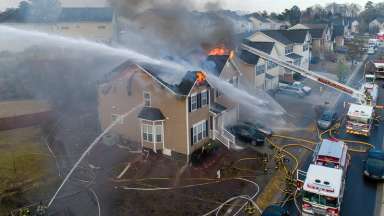When the fire department arrives at a building fire, they have descending set of priorities: life safety, incident stabilization, and property conservation:
- Life Safety - ensuring that all occupants are safely removed from the building, through both evacuation and rescue. Firefighters conduct primary and secondary searches inside the building and check all areas;
- Stabilization - involves controlling and extinguishing the fire. This also involves protecting exposures, which refers to nearby buildings or other structures in danger of also catching fire; and,
- Property conservation - involves actions to reduce or minimize the damage caused by fire, water, and smoke.
Fires within one or two rooms inside a building are typically fought as an interior or offensive attack. Firefighters take their hoses into the structure, and extinguish the flames inside the rooms.
Larger fires, such as involving an entire attic space or the upper-story of a building, are typically fought as exterior attack, this is also called defensive operations. Exterior attacks include hand hose streams, larger portable ground-based nozzles, and water streams from aerial devices.
Ventilation is an equally important tasks where firefighters use natural openings (doors or windows) or create openings (roof holes) to help remove smoke and heat from inside a structure. By doing so this helps firefighters search for occupants, and easily locate the seat of the fire.
The incident commander, also called command, supervises operations at a fire. Each company has a specific role, including fire attack, search and rescue, ventilation, rapid intervention team (one company ready to rescue any firefighters who become trapped), and safety (assessing hazards at the fire, such as downed power lines).
Water is carried by each engine company, with 500 gallons on each unit. While that amount is sufficient for most one- or two-room fires, the engine also connects to the nearest fire hydrant. This is called catching a hydrant. By connecting to a hydrant, the engine has an unlimited supply of water. Greater quantities of water are needed for larger fires. Additional engines may connect to the same hydrant to boost pressure.
